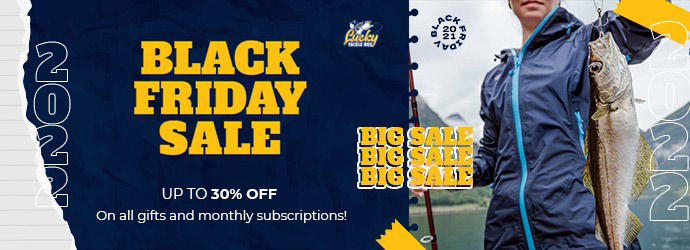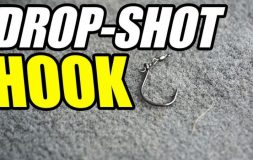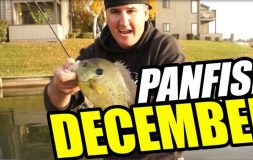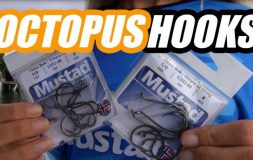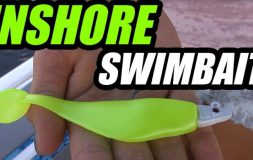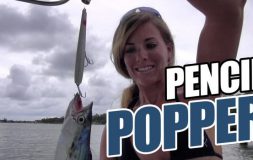How to use the V&M drop shad – Nick the informative fisherman
Nick breaks down how to use the V&M Drop Shad including rigging, retrieval, and location.
* Transcript below:
Large mouth. Big, big large mouth Jacob! Hell yeah!
What’s up guys? Nick the Informative Fisherman here on behalf of Lucky Tackle Box today and I get to introduce you guys to the V&M Drop Shad. This a little, small plastic that kind of fits something that we have coming up: the post-spawn and it is also is very effective during the spawn or those harder bites. So let’s get into this bait, and I’m gonna break it down for you.
This is a three and a half inch plastic. I think essentially it was designed around dropshotting, but I’ve been playing with it and I’ve found out that it’s way more effective than just dropshotting. It’s got a fat little body right here and it’s got a belly insert across the bottom which is gonna allow to tuck up the hook and get a little bit deeper of a hook set. And what I mean by that is if the hook had to push through all the plastic without a little slit going through the belly, the hook point may stick out a little bit if I stick out the back, but with putting the little belly insert like they’ve done here, what it allows the hook to do is slide up farther to where now the hook can penetrate the fish a little bit deeper. That little fatter body is nice. It’s gonna allow you to put a variety of hooks into that body and give you durability during the hook set and during the fight for your plastic not to tear off.
Then they have a really thin, light tapering tail on the back. What that’s gonna offer is very subtle movements of the rod is going to give a very subtle natural response out of this fatter bait and it’s gonna look very life-like under the water. What I got is a Green Pumpkin. I’m not sure what color you got, but Green Pumpkin is really nice. It can mimic a large variety of bait fish in regards to like Blue Gill and smaller like one-year juvenile bass. I find a lot of one and two-year bass look about that size and when there’s bass spawning and Blue Gills moving in on beds, this can be insanely effective or when there’s juvenile bass around and the bass are in the post spawn they love to eat those little one and two-year class bass and that mimics that perfectly.
Nice little drop shad fish. Out here, windy. It’s windy, this little buck was probably up building a bed but he seen that little Blue Gill come in there on the drop shot to invade his space. Now I’ll give you a little tip … I’m going to toss this fish back … the little tip is I had this short, because I thought they were going to be down on beds, but what I was doing is I had a long tag in sticking out my weight, but since I … it’s so windy I couldn’t see the beds, I set it long again to stay above that grass. But just like that, that probably was a bed fish, came up and ate it even though I couldn’t see him.
So let’s talk about rigging. Now essentially I said this bait probably was designed around dropshotting. Not 100% certain. Cliff Pace is a super versatile angler who’s is behind the development of this bait, so I’m sure he designed it for a large variety of things. So I have it on a drop shot setup right here. This is a size one mosquito drop shot hook. Now what I want you to understand is maybe you’re around the spawn, maybe you’re around the post-spawn, so there’s a couple things to think about in regards to dropshotting: how tall your grass is and are the bass associating to the bottom or are they associating to bait fish?
Now in regards to bass associating to the bottom, you may be around the spawn and this bait … see how high this hook up is from the weight here? That’s probably about 10 – 11 inches. If they’re spawning, you may want your weight right … lower. You know, within two or three inches and what it’s going to look like is a bait fish attacking the bed. So if you had that dropper set shorter, that’s probably going to be more effective if your fish are bedding, but if your fish are pre-spawn or post-spawn, having a taller dropper can be more effective. And if it’s a clear, calm day during the pre-spawn or post-spawn, if you know how tall your grass is … let’s say your grass is eight to ten inches and that’s sitting just that high over the grass, those fish during those calmer, cleaner skies and cleaner water are gonna bury themselves down in the grass, so the closer you get that to just over the top of the grass is also going to be insanely effective.
Now let’s say you’re fishing a lake without grass and you’re needing to make longer casts and cover a lot of water. Well let’s say it’s still calm, it’s sun bright, suns out bright, there’s no wind, it’s calm, the water is a little bit cleaner and you have to fish finesse to get those bites. You can do something like Ned rigging it. This is gonna be very effective right here. This is a 3/16th ounce ball head jig. This is a little mustad jig head and you can bomb that out and you can slowly reel it across the bottom. Yeah it would be nice to throw a big hard bait that you can move fast to find those fish, but if it’s post-frontal or if it’s calm and slick out you’re gonna need to finesse fish usually anyways to get those bites. So that’s gonna allow you to make a little longer cast and effectively fish the bottom if you don’t have too much grass. But if you do want to throw a Ned rig style bait in grass, reel it slow and anytime you feel the tension of that grass building up reel down and give your rod a little double snap and what that’s usually gonna do is that small hook’s gonna tear that grass free and your bait’s gonna be clean again, instead of consistently dragging it through there.
Now let’s saw you get a couple of bites or you see fish bedding around. That is a super effective time to throw the Neko rig. See how that bait is leaning head down like that? I have a little nail weight stuck in the head of this and I’ll show you a close up of a nail weight. It’s basically jamming the head with a little nail … so it’s in there, so now this bait is weighed forward and what I’ve done is I’ve taken that hook and stuck it through the back and brought it out to where that hook faces upright. And that’s gonna allow that bait to hop up and down off the bottom. If you have spawning fish around, it looks like a juvenile Blue Gill or a juvenile bass is in there now feeding on those eggs and they are going to destroy this thing. So that’s a few different varieties of rigging that up.
A little side tip I want to give right there: if you see Blue Gills around, a lot of Blue Gills, what you want to do is get yourself a little chartreuse marker pen, a little garlic scented chartreuse and you want to accent the bait. Little, small Blue Gills have a lot of chartreuse in them and this is why bass have this affliction for chartreuse. What you want to do is highlight the back and it’s generally their fins that have chartreuse. This is a little added bonus. Do you have to do this? No, but do you want to get a couple extra bites? Absolutely. I put a little chartreuse on the tail which accents the movement and makes the movement very obvious and I put a little chartreuse on the back. I’m not sure if the camera can pick that up but I’ll show you a close up on that as well. That’s gonna get you a couple extra bites. Especially if Blue Gills are down in there invading bass beds or if you see Blue Gills bedding during the bass post-spawn, they’re gonna come up there and try to feed on those Blue Gills and that’s going to mimic that a whole lot better.
So we found a little buck on a bed, so I’m using the Neko rig style right here. I gotta back off my trolling motor a lot. We’re at about 50, 60 feet and I’m skipping that Neko rig up into the bed. I would love to throw a drop shot just because I can keep it there and shake it there, but the Neko rig kind of has the same ability, but the drop shot you can’t skip up there and this is a long range fish. He only wants to protect when I’m far away. Even right now we’re probably within 50 feet maybe and he doesn’t want to protect, but once we drift out to 60, 70, 80 feet away and I don’t touch the trolling motor for about a minute he’s much more active. Like right now I can see him nosing, so I’m opening my spool and I’m backing off and try to just shake it on loose line so I don’t drag it away.
All the way out off the bed floor. Oh! In and out of his mouth. So now the issue is it got hung up in that grass and that irritated him. So now the issue is we’re way off here, so I have to creep up, try to land the cast and ease back out. That’s how leery this one is. I’m gonna have to work for this but we’re going to get him on that Neko rig because it seems to setup he wants. It’s down there hopping and dredging into his bed looking like it’s invading. I might even add some chartreuse to this setup right here just to make it look like a Blue Gill.
Nick Smith: It just dropped to the outside corner of his bed, but now we’re close so let’s see if he’ll protect. His fins are … got him! Oh and he’s off! He didn’t have it for very long, so one key thing is when you see a bed fish and you hook him, if the bed fish’s head never comes up or they never splash the surface you can generally get them to strike again. But if you move them four or five feet on a hook set, you generally need to give it about a hour before you come back to them. He got on, he was on hooked up and got off real quick, so we should be able to get him. Here he comes. Got him. And he’s off. No!
So now we need to see what happens, because I towed that guy over four feet on that hook set. We might get lucky. He was real leery to start, so chances are we won’t be able to get him but that Neko rig came through. Either way, fish got lucky.
Alright guys, so he seemed to catch on to the Neko rig version of it, so I tied on the Ned rig version. It’s a little heavier; 3/16th ounce head right here. It’s not gonna skip as far, but it’s gonna rough up the bed a little but more and show him something a little bit different. This is all I brought with me. We’re just changing the rigging now that he’s caught on to the other.
Yup, doesn’t like the Ned rig. He’s getting pissed. There we go. We got him. Little beefier exposed hook this time. Better fish than I thought he is. A lot of the time when they get right up near the boat and they’re real surprised, sometimes I’ll click off a couple times on my drag because they’re usually gonna go for another run. Just like that. This isn’t a inexperienced move to do. When you see that fish start to nose down because that’s when you’re gonna get all that surge in your line … when they’re real close you have less stretch in your line and when you’re fishing light line somethings much more liable to happen the closer they are to the boat. Like a break off. You probably notice that from time to time.
Oh yeah. Another little tip. When you’re landing fish next to the boat, you want to leave about the same length of your rod, the same length of line out to your rod and the reason for this is when you’re picking your rod straight up above your head it still keeps the fish really close to you. So if you see a lot of anglers feeding line right at the boat a lot of the time that’s what it’s for. To where if I put this rod behind my head, now this fish is still within landing range for me. And there we go. This guy is a little beat up. He’s been up there for awhile. That little Ned rig, nice little chunky, maybe mid twos. Nice fish. Let’s send him on his way so he can get back to business. He’ll probably be right back up there on that bed within the next 15, 20 minutes, so awesome.
So let’s talk a little bit about rods, reels and line to throw these finesse style baits here, the drop shad. Now what you really want to look at is, it’s a finesse presentation, you want it to look natural, so this is where you want to use fluorocarbon line. Fluorocarbon line is very sensitive, it’s low stretch and it’s virtually invisible to the fish. How is that going to help you? It’s simple. You’re trying to get more bites, it’s tougher conditions, you’re throwing a little plastic. You want to get as many bites as you possibly can and fluorocarbon is going to give that to you. Especially if you’re fishing deep, you’re going to feel the instantaneous response.
How I look at it like this is the lighter the line I go … I’ll fish finesse stuff down to four pound, though if you’re not an avid angler I would suggest six pound being the lightest and probably eight pound being the heaviest. It’s not much of a variable. It’s basically the next line weight up, but what that’s going to offer you is if you have a tiny, little exposed hook … alright … you don’t need a big powerful hook set. All you need to do is start reeling into the fish to where if you were fishing that little Neko rig, which is a very light wire hook, or a little drop shot with a very light wire exposed hook, six pound fluorocarbon and a very light spinning rod is gonna be the deal for you.
The lighter the line you go, the more bites you’re gonna get, but let’s say I’m throwing it on that Ned rig head right there. This is probably a better bet to do eight pound fluorocarbon. Or if I’m throwing it on like a shaky head. Little stouter hook. Or maybe it’s Texas rigged and the plastic is covering that hook point and I need to set the hook a little bit harder. So that’s where I would want to throw eight pound. But if you want to be universal, fish eight pound across the board and you don’t have to worry about those extra strikes. I’m just So in regards to a rod, I like a medium or a medium-light spinning right. And I like a longer rod. What happens is when you’re fishing lighter line or a lighter hook, I like a softer rod. I like a moderate or a moderate-fast action rod, or if it is a fast action I like a lighter power rod. That’s gonna allow the rod to serve as a cushion for that lighter line. If you have a big stiff rod and you go to lean on the fish, there’s not much cushion. That little hook can either tear through them or you’re going to snap your line. The longer the rod, the better. You’re going to make a longer cast easier. Then if you feel the fish hit it and you start to pick up, you’re moving a lot of line. The longer the rod, the longer the cast and the more line you’re going to pick up on a hook set. So I prefer at least a seven foot rod all the way up to seven eleven if you have it, is going to be perfectly fine.
Now in regards to a spinning reel. Really what you want is one with just a smooth drag. And you want to make sure your drag’s tied just tight enough to where it’s going to give that fish drag when he’s taking off on you. There’s nothing saying you won’t hook the six or seven pounder on this. I’ve caught tons of giant fish on little finesse plastics under the right conditions. So if you have that drag too tight, same things gonna apply. You’re gonna tear that hook free or you’re gonna break that line, so make sure you have just enough tension on your drag to get that rod into its action point and then let it start feeding off line. Those little tips right there are gonna put a lot more fish in the boat for you.
Oh yeah. Oh. Nice one on the drop shad. He cooled my toes off! Almost. Come on baby. Yeah! There’s a nice chunky drop shad fish. He wanted it with that huh? The chartreuse highlights give him a little Blue Gill accent in there and fired him up.
So when would I fish the drop shad? There’s a few things to look at. There’s matching the hatch, there’s tough conditions, there’s time-of-year/cold water or time-of-year/very hot water. So let’s start off with matching the hatch. If I see that the bait fish around are smaller Blue Gills primarily and I see bass around that zone, I want to always try to match the hatch first. That’s a good rule-of-thumb to do. A secondary idea: so let’s say you don’t see the bait fish around, you don’t know what they look like. A small finesse plastic is always gonna get you extra bites, especially under tougher conditions.
When else would I fish this? Simple, I mentioned it earlier, after a front or I’m just not getting bites on a moving bait, a reaction bait, a crank bait, a chatter bait. I’m not getting bites. Now I now I need to finesse fish. That’s also a fantastic time to fish these to get extra bites and don’t rule this out. Let’s say you went down a bank and caught him on a chatter bait, a jig and stuff like that and you went back through and you didn’t re-catch him on those other baits. Coming back through a second, third or fourth time with a finesse plastic is also deadly effective to get the fish that didn’t strike your reaction bait. You know more than likely there’s quality fish there and if you went back through with a finesse plastic you’re gonna get additional catches instead of running new water trying to find more fish.
Another time: when that water is below 50 degrees. When that water starts entering the 40s, finesse plastics, those big fish are lethargic, they’re cold, they’re going to eat whatever is in front of their face. It’s a great time of year to fish finesse plastics like this drop shad here and get those bigger fish. The same ting happens if you get water over 85 degrees. It’s very hot, the fish are lethargic, they’re gonna eat whatever comes in front of their face again. So those are some awesome tips for you guys to hopefully catch some more fatties on these bad boys.
I’m Nick the Informative Fisherman and that’s the V&M Drop Shad. Remember guys, if you liked this video make sure to click the subscribe button below. Follow us here at Lucky Tackle Box on Instagram, Facebook, any social platform. We are on there. We greatly appreciate you guys watching and we’ll see you next time. Best of fishing.
To learn more about our fishing subscriptions, make sure to check our website. We have a great variety of fishing tools, suitable for any angler.


